Archive for Tips & Ideas
September 26, 2008 at 10:42 am · Filed under Tips & Ideas, Travel / lifestyle musings
For all of our cheapskate travel, we don’t often spend time in truly free campgrounds. We seem to either be in paying situation or staying off the established campground system, in private driveways, parking lots, and county parks. Free campgrounds are widely available but generally they are also scattered far off into the boondocks. The US Forest Service maintains a lot of free campgrounds in national forest areas, and the Army Corps of Engineers also has developed quite a few. The Bureau of Land Management has many, which they divide into short-term and long-term visitor areas.
 If you are looking to really get away, these are great options. We tend not to use them because they are often too small for our rig, too rugged to get into, or too far from services that I need for work. But on occasion we have, and they’ve always been nice spots, often located near rivers or open recreation areas.
If you are looking to really get away, these are great options. We tend not to use them because they are often too small for our rig, too rugged to get into, or too far from services that I need for work. But on occasion we have, and they’ve always been nice spots, often located near rivers or open recreation areas.
One nice thing about free campgrounds is that there’s no rush to get out before “check-out time.” They usually have a 7- or 14-day limit, but there’s often no need to register at all, so you can just pull in at your leisure and you’re left alone.
On Thursday we were all set to go, since we’ve explored most of Navajo National Monument, but then in the morning a few work tasks came up that I needed to deal with, and we decided it was smarter to just stay for the day and get things done. The sun was shining brightly all morning and so we had plenty of solar power for the laptop, and if I stood on the picnic table and faced a large juniper tree to the east, I could reliably make phone calls. That gave me the full complement of technology I needed to get my job done.
Being in a free campground there was obviously no cost associated with this extra day’s stay, and in fact we were saving money by not moving. To top it all off, the campground is undeniably pretty. If we’d moved we might not be in such a nice spot, so why rush away? When you find a nice free campground, stick around and enjoy it. With gas prices as high as they are, it makes sense.
Our extra day has yielded a few unexpected perks. In the afternoon a bit of weather moved in, to our great surprise, and we actually got an hour or so of light desert rain. It is is so dry here that we were able to stand out in the rain talking to neighbors without actually getting wet. Since desert rain is scarce this time of year, it was sort of a treat.
Our neighbors a few sites away turned out to be a couple from FL with two homeschooled children, who had previously spotted us in Grand Canyon and Page. The kids were six and eight years old, so Emma was completely engaged all afternoon. They are going to do the Betatakin hike today.
This morning we really are going to move on. The plan is to try to find some place to do laundry in Kayenta or Chinle (both rather small towns, it’s a long shot), and then proceed to Canyon de Chelly National Monument for the weekend. The camping at Canyon de Chelly’s Cottonwood campground is free, too. I am told that there is little chance of me getting online this weekend, but I’ve been told that every step of the way in the last month and yet somehow we managed to do it most of the time.
But first, we have one more surprise from the desert. We hear long rumbles of thunder in the distance. At 7:30 a.m. in late September (and a 10% chance of rain in the forecast) we didn’t expect a thunderstorm, but there was clearly one out there to our south. It threw a few sprinkles our way, and now has moved on, so we will too.c
September 12, 2008 at 5:21 pm · Filed under Tips & Ideas
We’ve moved on from Bryce Canyon to Kanab UT for a few days. It’s time to resupply the ship and do some serious work.
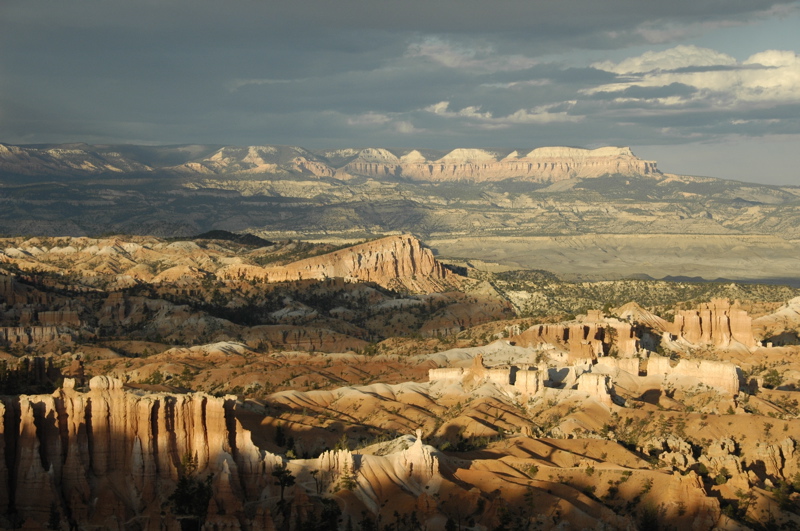
Our last hike in Bryce yesterday was terrific, and I’ll have photos uploaded to Flickr soon. But there’s no getting away from the fact that the park is crowded. We rarely had solitude, which we’ve come to expect often in other national parks. We would have had to hike many miles from the rim to get the sort of peace that is available in abundance at less popular parks.
Looking at the park service’s report on 2007 visitation yesterday, I was curious to see some of the least-visited parks that we’ve been to. Given that we like quieter places, I was wondering which ones we’ve missed.
Turns out we’ve missed a lot of them. Of 360 parks in the report, the least-visited one we’ve been to is Fossil Butte National Monument (Wyoming), ranked #314 overall with 19,853 visitors. I remember that visit well. Emma got a lot of attention from the rangers, and only a handful of people walked into the visitor center while we were there. It was also memorable for the broken lug stud later that day.
Hovenweep NMON in Utah ranks #305 in the list. We loved that place for its solitude, the unique Ancient Puebloan ruins, and the beautiful campground.
Before we started full-timing, we visited St-Gaudens National Historic Site in New Hampshire (#303), and I remember parking our 1968 Airstream Caravel on the grounds (there’s no camping) for the afternoon. It’s a nice site, attributed to a famous artist, but slightly obscure.
Vermont’s only national park is Marsh-Billings-Rockefeller National Historic Park. Until a few years ago, we didn’t even have that one, and the only slim presence of the park service was the Appalachian Trail. We’ve visited it several times. It’s ranked #296.
Ft. Laramie NHS (Wyoming) is #286. This is a great piece of western expansion history and worth the small detour to visit. If you’re already wandering through Wyoming you’re off the beaten path, so why not explore a few miles further?
Gila Cliff Dwellings NMON (New Mexico) is #284. We visited it when Eleanor was very pregnant with Emma, in early 2000, making it Emma’s first national park. The ranger who guided us was extremely concerned about Eleanor’s condition, since she was in that point of the pregnancy where she looked somewhat like a kangaroo. But we were the only people on the trail that morning and so we got a very personal guided tour, up and down the ladders of a cliff dwelling.
We’ll be making a point of seeking out some of the less-visited sites in the future. Tomorrow we are planning to spend part of the day at Pipe Spring NMON (#277), only about 35 miles from Kanab. When we get back to Tucson, we’ll finally make a trip to nearby Tumacacori NMON (#280), too.
Looking through the list, I see “the ones that got away,” and now I’m sorry we passed them by. When we went up to Scotts Bluff (Nebraska, #214) we made a decision to skip Agate Fossil Beds (#332) because it was hard to get to and there weren’t any facilities. In all the years we lived in the Boston area, we never once visited Saugus Iron Works NHS (#348). Last fall when we were in Montana we skipped Grant-Kohrs Ranch NHS (#321), which was a shame. Bert Gildart even mentioned it in an article in Airstream Life a couple of issues ago.
Well, you can’t see them all, although some people are trying. In Great Sand Dunes we met a guy who was up over 200 parks so far. He’d been at it for decades. He even bagged some very remote and hard-to-reach parks, such as the National Park of American Samoa, Dry Tortugas NP (Florida), the Virgin Islands parks, most of the Hawaiian parks, and all of the Alaskan parks. He was seriously dedicated to the task, even to the point of tracking new national parks that have been proposed so he can plan visits.
 Collecting the National Parks Passport stamps at every park has been something we’ve been doing since 1997. It’s a great way to keep momentos of your travels in a cheap and portable format. The ink stamps are free, and since there are hundreds of them, you can collect for a long long time. Some people feel rather passionate about it and go to extraordinary efforts to hit as many parks as they can. We’re taking a more measured approach, just visiting the parks as we see the opportunities. Still, with all this time traveling, we’ve accumulated 110 stamps so far.
Collecting the National Parks Passport stamps at every park has been something we’ve been doing since 1997. It’s a great way to keep momentos of your travels in a cheap and portable format. The ink stamps are free, and since there are hundreds of them, you can collect for a long long time. Some people feel rather passionate about it and go to extraordinary efforts to hit as many parks as they can. We’re taking a more measured approach, just visiting the parks as we see the opportunities. Still, with all this time traveling, we’ve accumulated 110 stamps so far.
More surprising to me is that we have absolutely no stamps from the “National Capitol Region”, which includes Washington DC. That’s the easiest place in the world to collect stamps because of all the national park sites clustered in the District. We’ve been there many times, but for some reason I always forget to get the dozen or so stamps that can be found there.
After my photo collection, the battered blue Passport book is my most prized souvenir. I recommend that anyone who likes visiting national parks buy this inexpensive book and start collecting the stamps too. Each one reminds me of a great time in a great place, and without this book I would probably forget the dates of our visits. Big or small, every national park has been a place we’d like to remember.
August 22, 2008 at 11:22 am · Filed under Tips & Ideas
The Democratic National Convention is driving us out of town. We didn’t realize when we booked our stay that the DNC was coming, nor the massive impact that it would have on everything near Denver. It is already nearly impossible to drive near the city, and things will only get worse when Sen. Obama shows up next week. All the state parks are booked solid this weekend, so we have to bail out today.
Otherwise we might have stayed another week. We’re always very comfortable in Cherry Creek State Park — it’s one of our favorite places to go. Not only is it a beautiful and super-convenient oasis right in the middle of Aurora, but we have lots of friends and collaborators in the area. If Airstream Life magazine had a fixed headquarters, it would be in Aurora CO. Three major contributors live here: Jody Brotherston, Fred Coldwell, and Forrest McClure. Many members and leaders of the Vintage Airstream Club are in Denver. TTT is in nearby Wheat Ridge. We’re near the center of the country, and the Denver climate is decent most of the year. This area has a lot going for it, Airstream-wise.
We caught up with Jody at her home on Wednesday night, for a superb dinner out on the patio, and saw Fred last night at a local Mexican restaurant near his home, too. Forrest is off on a caravan this week, so we couldn’t connect with him, but otherwise we’ve managed to do the rounds of business associates.
Brett flew home on Thursday, so the Airstream is now larger inside than it was. We had him with us for ten days, and it was a pretty good time all the way, despite the fact that he made us all sick. I suppose that’s a testament to our long friendship, because if it were anyone else we probably would have pitched him out somewhere in Kansas. As with all Airstream relationships, we don’t know when we’ll see him again, but we know we’ll see him someday.
I spent quite a bit of time yesterday morning developing a highly detailed trip plan for the next few weeks. In all our travels we’ve never researched and recorded such detail. But this trip is different from all others. In Utah, the parks are remote and resources are scattered. Internet, fuel, repairs, supplies — all will be sporadically available as we make the loop through Utah from Canyonlands to Capitol Reef to Bryce to Grand Canyon and finally to Page AZ.
Because I must work on some heavy projects in the next few weeks, I tried to work up a plan where we can alternately stop in a campground with connectivity to the Internet for a few days, and then disappear into a park for some hiking and exploring. It’s not a perfect plan, so we don’t have reservations and we are prepared to make sudden changes as events warrant. But Eleanor and I have a document on our computers now with phone numbers, addresses, resource notes, dozens of local maps, wifi locations, recommended campgrounds, Ranger programs, fuel locations, operating hours, and many other details for each stop. It should be enough to allow us to fumble through Utah for a few weeks.
The Internet, as always, has been instrumental to my research. I usually have four or five browser windows open simultaneously as I plan (as well as a paper map). My favorite sites for trip planning include:
National Park Service: great info on every national park site. This is the first place to go when planning a park visit.
RV Park Reviews: If you need a campground outside the national park, this site gives you great info from people who have been there. Be aware that the price other people paid isn’t what you might pay, so be sure to visit the specific campground’s website as well.
RV Dumps: Good for finding dump stations along the route, if you are going from one extended boondocking (or courtesy parking) situation to another. Most dump stations listed here are along highways but sometimes in small towns.
Google Maps: Excellent trip mapping tools. You can grab the route suggested and drag it on the screen to explore alternate routes.
Recreation.Gov or ReserveAmerica: These are both powered by ReserveAmerica, and are THE way to make online reservations for most national and state parks.
Bureau of Land Management: If you are traveling in the western states, you’ll find some sites are BLM rather than NPS. This includes places like Grand Staircase-Escalante National Monument. The BLM site is not easy to navigate, but click on a state and then on a region and you can fumble your way through to the place you’re interested in. BLM also operates a lot of primitive campgrounds that are free or very cheap.
There is so much in Utah to do that I have been forced to trim several places from the trip plan. Vermillion Cliffs NWR is going to be saved for another trip. It’s a massive hiking destination and deserves a couple of weeks all by itself. We may have to skip Canyon de Chelly, Rainbow Bridge, and Navajo too. The White Mountains and Monument Valley in northern AZ may get skipped if work starts to become an issue, but we can get back up there from Tucson pretty easily. It pains me to pass by great spots like these, but I also don’t want to blow through them in a hurry.
Instead, we’ll concentrate on Canyonlands, Capitol Reef, Bryce, and Grand Canyon’s north rim. Even still we’re not giving them their due, but I am hoping 2-5 days in each will be enough to at least get to know them a little and plan a follow-up trip another year. If we find one park we particularly like, we may stay much longer, which is the major reason why we aren’t making reservations right now. Instead, we’ll make reservations every week for the next week’s stops.
While work is a huge factor right now, the other deadline is the season. September is a great time to be in these parks, which run from 4,000 to 8,000 feet in elevation. But by mid-October things will be quite different. Campgrounds will start shutting down and, nights will be close to freezing, and sunsets will be very early. I think we’ll want to be moving to lower elevations in October, below 4,000 feet.
That still leaves the possibility of Canyon de Chelly, Navajo, Wupatki, Sunset Crater and other spots, so it’s not a hard deadline, just something to keep in mind. In the west, weather is not determined by latitude as much as altitude. (Having a topographic map would have been extremely useful in this trip planning process, and if I find a good one for southern UT and northern AZ during our travels I will probably buy it.) When things really start to get chilly, we’ll be in Tucson at 2,000 feet, settling into our winter home base.
August 14, 2008 at 9:53 pm · Filed under Tips & Ideas
We’re on the road from Jackson Center OH heading west. Our last meetings wrapped up at 11:30 this morning. We packed up, topped off the propane, dumped the tanks, filled the fresh water and took on 14 gallons of regular unleaded.
In this phase of our travel, fuel is by far the largest expense. Over the next few days we’ll cover about 1200 miles to Denver, which will cost about $450 in fuel at current prices. Anticipating this, I switched credit cards a month ago to cut the cost.
Many gas station chains have credit cards that give you a discount of 3% to 5% on fuel, but they only work at their gas stations. Since we travel nationwide, that’s not very useful to us. In Tucson the predominant gas chain is Circle K, in Ohio we see a lot of Speedways, out west we see BP and Sinclair and ARCO, in some places we see Texaco and Shell, or the big boys: Exxon and Mobil. It’s impractical to carry a card for each individual chain, so I found a card that gives me a discount at all of them.

The card I chose is the American Express “SimplyCash Business Card.” I think they have a similar one for consumers called BlueCash. I use it to pay for all our fuel, and I get 5% (not five cents, but percent) rebated to me on the next credit card statement. So the gas at Marathon that was posted at $3.75 per gallon really costs us $3.56. No matter where we go, we’re getting the cheapest gas in town.
Five percent isn’t a huge amount, but it feels good to save anything on gas these days. We typically save $2-3 per fillup. Hey, every bit counts.
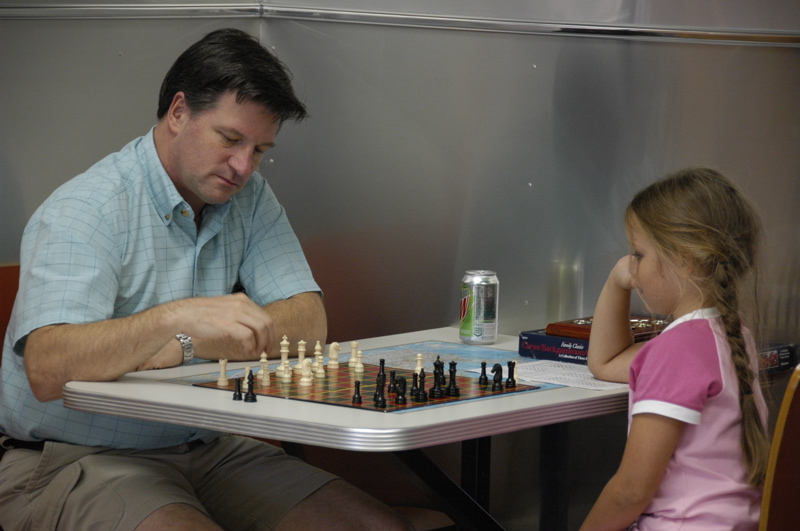
Brett gives Emma her first chess game in the Airstream service center
Rob Baker (of The Vintage Airstream Podcast) and family pulled into Airstream’s Terra Port as we were readying to depart. Rob has a very nicely restored 30-foot 1958 Airstream Sovereign Of The Road. I got a quick peek inside before we had to go. Beautiful Zolatone paint inside, Marmoleum floor, and birch cabinetry. Since they’ve never been to Jackson Center before, we gave them the quick rundown on things to do in town (and a few places to avoid). It would have been fun to stay another day with Rob, Zoe, and the kids, but the road was calling.
Tonight we are doing our usual cheapskate thing on long drive days: the scenic Wal-Mart Supercenter off I-70 in Illinois. I’m amazed we made it this far given how late we left, and also considering that I now have a cold. I don’t want to name names, but a certain visitor to our trailer from Florida whose initials are BG seemed to have brought it with him. He lost his voice entirely yesterday and spent the day whispering through all our meetings, and today I am sharing the joy with a sore throat, headache, and congestion. Still, with some Tylenol and Sudafed we made it over 300 miles. Tomorrow we have another long-ish day planned, and then we’ll slow down for a while to explore some of Kansas.
August 12, 2008 at 8:38 am · Filed under Tips & Ideas
Our trailer service is done. The bottom line was $1500, with ceramic brake pads all around, one replaced rotor, axle alignment, a new bumper, straightening and repainting of the rear scrapers, and a few small parts.
Today at the Airstream factory Brett and I will be running around trying to meet with various people on the staff, and conducting a few interviews for future articles in Airstream Life. One interview was done yesterday afternoon, with John Huttle. He’s the head of Airstreams “B-van” division, which includes the new Interstate 3500 touring coach being produced in a separate building across the street from the main assembly building. We took a tour of the assembly process (not part of the public tour, sorry) and were quite impressed by the complete redesign of this new little motorhome.
I need to do several follow-up interviews today and over the next few weeks to get together a good story about this completely re-designed product. That article should appear in the Winter 2008 issue of Airstream Life.
Since the bulk of the day will be filled with business tasks, I am going to take the opportunity to share with you a few good links which have been passed on to me by blog readers recently.
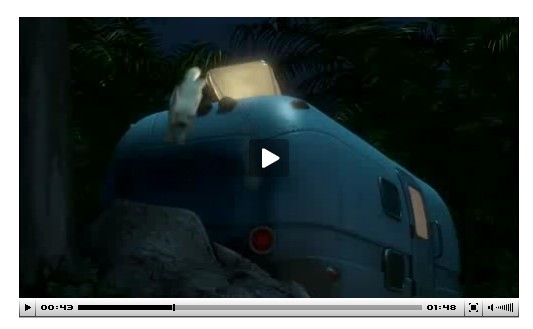 Andy writes: “For one brief, er, it would have been a shining moment if it was the daytime, an almost Airstream is the trailer that appears in the trailer (couldn’t resist that one) for the Disney movie ‘Bolt.’ The shape of the trailer (travel-trailer, that is) is definitely Airstream, but the side details look a bit different, like there’s a recessed waistband or something. The travel trailer appears about 1/4 to 1/3 of the way into the movie trailer.”
Andy writes: “For one brief, er, it would have been a shining moment if it was the daytime, an almost Airstream is the trailer that appears in the trailer (couldn’t resist that one) for the Disney movie ‘Bolt.’ The shape of the trailer (travel-trailer, that is) is definitely Airstream, but the side details look a bit different, like there’s a recessed waistband or something. The travel trailer appears about 1/4 to 1/3 of the way into the movie trailer.”
Al wrote in a comment yesterday that there was a recall on valve stems going on. I haven’t yet verified if our stems are in the recall, but here’s the link for more information about that.
Brad writes in from Oregon to tip me off to a good article about the rising ukulele phenomenon. (Registration may be required to view this article.) When the New York Times covers it, you know you’ve made the big time, right? Hey, even Warren Buffet plays the uke. He thought it would get him girls. (Hey Warren, it didn’t work for me either.)
Some fellow full-timers, Jim and Debbie, have been keeping a blog of their travels for some time. Since the travels of Bobby & Danine (“A Year About”) have come to an end, their blog will be replaced on the Airstream Community page of this website with Jim & Debbie’s “Dreamstreamr Odyssey.” But I still advise anyone planning to take an extended tour in their travel trailer to read the archives of A Year About. It’s fun to read about their adventure and very informative as well.
Deb and Jim have been particularly helpful in advising us on methods and concerns related to obtaining good nationwide health insurance for full-timers. Deb has written up a short article on that subject, which contains useful information for anyone trying to figure out individual health insurance while traveling.
That ought to keep you busy while I’m running around Jackson Center all day. More later. Let me know if there’s a photo you want me to try to take while I’m here.
June 5, 2008 at 10:37 pm · Filed under Tips & Ideas
To serve you better, we are changing the terms of this blog. From now on, all entries will be written in Esperanto, and upside down. This will help you learn a second language, and improve your brain’s ability to process spatial relationships. We trust you’ll continue to enjoy the blog as we continue to improve service to you …
Now, if I really did that, would you continue to read this blog or would you tune out? (That’s a rhetorical question.) Yet many businesses pull that sort of shenanigan all the time. I always cringe when I get a letter from a bank with the dreaded phrase “to serve you better” because that inevitably means “raise your fees,” or “discontinue a service you’ve been using.” I have yet to get a letter from a financial institution with the phrase “to serve you better” that didn’t have some very significant asterisks attached to it.
The latest in a long line of bonehead customer service maneuvers comes from Discover Card. Over the past year Discover seems to have been trying as hard as possible to drive us away as customers, and they’ve finally succeeded.
The first “improvement” in service to us was last year, when Discover announced that they were discontinuing e-billing. For people who are busy, who travel a lot, or who use their computers a lot (and all three of those apply to us), e-billing is a godsend. It means that instead of waiting for paper to catch up with us in the mail, we can use online bill pay service to receive our bills and click-click-click pay them.
Everyone offers e-billing these days. We only have one routine business relationship that doesn’t offer e-bills (the City of Tucson, for water/sewer bills). We get e-bills for our mobile phones, utilities, mortgage, insurance, credit cards, and all sorts of other things. But for some unexplained reason, after providing us with convenient e-bills for years, Discover suspended the service. It was, as they explained at the time, an opportunity for them to improve service to us.
We rewarded that bit of customer dis-service by suspending use of the card. I suggested closing the account at that point, but Eleanor kept it for an emergency.
Now, several months later, they have taken further steps to improve service to us, by changing our account number without prior notice. We received the following blather via snail mail and email today:
We’re now able to offer you enhanced features and benefits as part of a systems upgrade. As a result, your account number has changed and we’ve mailed you a new card that replaces the card you currently carry. If you haven’t received it already, your new Discover Card will arrive soon.
To understand our frustration, you need to appreciate a little bit of how we (and millions of other people) manage their finances. We routinely ask vendors who send us small monthly bills (like Sprint, and Verizon) to bill the charges automatically to our credit cards. This consolidates the bills into one convenient statement, which we pay in full monthly. When the credit card number changes, all of those billing relationships break.
I do this on the business side too. For example, if Bank of America spontaneously changed my business VISA card number, I would have to contact over twenty vendors to update their billing records — or watch all those invoices go unpaid, with the ensuing mayhem. Have you ever tried to contact twenty businesses to update your billing information? I did it in March and it took almost two full days to reach them all. I logged a lot of time listening to Muzak on hold, let me tell you.
(Discover’s letter to us says “we’ll attempt to update your account information with those merchants.” [emphasis mine] Will they guarantee we won’t pay late fees if their attempts fail?)
If Eleanor had trusted Discover in the last six months, we might have been facing that exact scenario as a result of this “systems upgrade.” Fortunately, Discover already showed us the color of their stripes last year. We had entrusted them with nothing, thus our loss in this case is zero — and Discover’s loss will be a customer.
I rant about this because there are implications here for those who travel a lot. Traveling means a more complicated life in some ways, and so you need to look for other ways to simplify the routine stuff. In other words, if you are going to be busy enjoying your travel experience, it helps to eliminate the mundane things (like writing checks and fighting with banks). So you need to find relationships with companies you can trust, ones that manage their systems with your interests in mind, not just their own.
By the way, if you’re wondering what improved services we may be missing out on by canceling our Discover Card, here’s another quote from the letter:
Enhanced security monitoring will help detect fraud earlier on your account. And with personal concierge services, you can get reservations to your favorite restaurants, score tickets to exclusive events and more “” all at no cost to you.
Oh joy, just what I wanted … more services I won’t use. And enhanced security monitoring is mostly to their benefit, since by Federal law my liability for unauthorized misuse is limited to $50. But wait, there’s more!
Finally, start managing your account online.
“¢ View your current account balance, rewards account balance, and past 12 months
of transactions by date, amount or category.
“¢ Make online payments, set e-mail reminders, and more.
Uh, Discover … just one question. With all these great new services, will you finally resume providing the one service I really needed — e-bills — again?
May 25, 2008 at 6:23 pm · Filed under Tips & Ideas
A lot of people have been talking about how increasing fuel prices will affect RV and vacation travel. The general consensus is that Americans aren’t ready to eliminate the things they love, which includes traveling, but people are ready to cut back some.
We’re included in that. The easiest thing we can do to combat increase fuel costs is to drive less. It’s simple. There’s so much to see and do in this country that you don’t have to go terribly far to find interesting things. Although we are crossing the continent (and will do so again in late summer), we are finding that it’s not difficult to cut miles out of the route and still be well entertained along the way.
In fact, we are finding that taking the “blue highways” (non-Interstate highways in other words), we travel more slowly, save fuel, and see little things that we would have missed in a rush to get somewhere else.
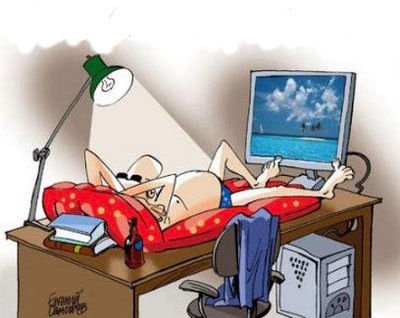
A “Staycation”
Bert wrote to me today about his travel plans this weekend:
This Memorial Day Janie and I are taking a “Staycation,” a new word that I bet becomes a little more popular as time goes by. What people should learn to do (even when traveling) is to park a little longer and learn to use kayaks, bikes, hiking shoes, etc.
Bert & Janie are experts at that. They get to a place and really work it over, using their own muscles and imagination. We’ve been guilty of hitting a great spot and bailing out after a few days when there was still much more to do, and as a result we rarely get as much out of a place as they do. When we parked together in Yellowstone last October I was at first leery of their intent to stay five or six days, and every time Bert said, “I think we might stay another day to go see the XXX…” I’d be thinking about our next planned stop.
Well, I was glad we hung back and followed Bert & Janie around. They reminded me that just puttering in a park (taking photos, mucking around looking for moose, exploring town) is way better than a day in the office. We ended up in Yellowstone and West Yellowstone for eight or nine days, I believe. I came out of there far from bored, but instead having a much higher appreciation for the park and looking forward to coming back.
A Staycation is sort of what we are doing here in New Hope. We could be driving all over the place but instead we have been spending most of our time on site just enjoying what we have right here. Every day we spend here is an opportunity to build up the treasury for the days we need to tow the Airstream, and a chance to discover something small that we otherwise would have overlooked.
I want to put together a list of similar ideas, which will show people how to save money RV’ing. I want the list to go beyond the usual “make sure your tires are inflated” sort of advice. Those tips are useful but we’ve all heard them before. What can we do to really cut our expenses and yet still have an amazing trip?
One idea I know people have caught onto is to explore local state parks. I’m getting regular reports from people saying that state parks are filled to capacity nearly everywhere this weekend. State parks are generally cheaper than campgrounds and are usually in great locations.
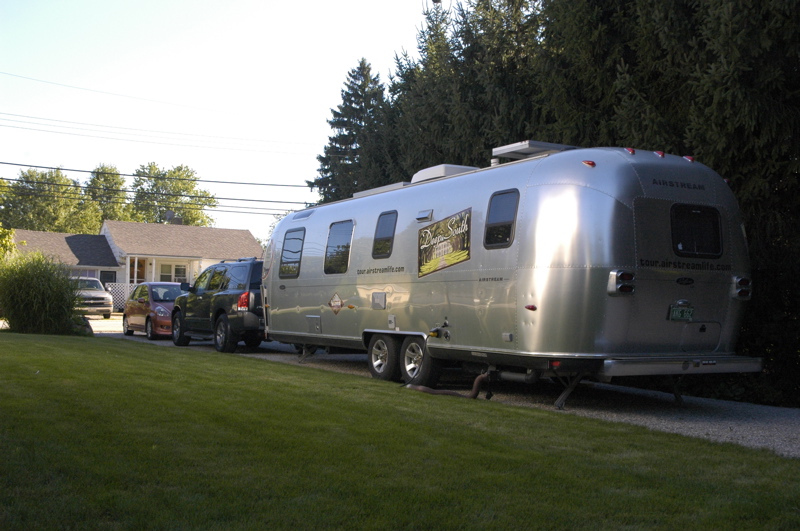 Another idea is to courtesy park at a friend’s house instead of a campground, if you know someone who can host your rig. The money you save ($25-35 per day, typically) can offset higher fuel cost. With this idea, you can’t wait for someone to offer. You have to ask (gently) if they would be willing to host you, because the idea won’t occur to anyone who doesn’t already own an RV. It’s a good way to reconnect with old friends, and many will find it an exciting novelty to have you visit in your rig.
Another idea is to courtesy park at a friend’s house instead of a campground, if you know someone who can host your rig. The money you save ($25-35 per day, typically) can offset higher fuel cost. With this idea, you can’t wait for someone to offer. You have to ask (gently) if they would be willing to host you, because the idea won’t occur to anyone who doesn’t already own an RV. It’s a good way to reconnect with old friends, and many will find it an exciting novelty to have you visit in your rig.
I’d also like to debunk some of the less-useful advice I often hear or read in RV magazines and books. For example, you’ve probably heard the advice to travel with an empty water tank, or lighten your RV, to save fuel. While this does have an impact, it’s very small in the overall price of the typical highway trip.
We’ve never been able to document a significant MPG difference by traveling with an empty water tank even though that’s a difference in weight of about 300 lbs. The reason? Most of your fuel economy is based on the aerodynamic efficiency of your rig, not its weight. Weight makes a huge difference to jumbo jets, but not nearly as much (as a percentage of overall fuel used) to trucks.
It would be better practice to look at your truck & trailer and try to find opportunities to streamline them. Maybe this is the time to remove some optional attachments that are contributing to your trailer’s parasitic drag coefficient, like that giant satellite dish, ham radio antenna, and curbside window awnings? I know you love those things, but it’s just a suggestion. Even better would be to replace your square-cornered RV with an aerodynamic one (hint, hint) that gets 20% better fuel economy! (But wait till the old one is worn out — you don’t want to lose all your potential savings in depreciation cost instead.)
Here’s another one: switch your non-tow vehicle to something fuel efficient. That’s why we drive a Nissan Armada when we are towing, and a 37 MPG Honda the rest of the time. Filling the tank of a big SUV can cost up to $150 these days, and yet people still drive them around town for commuting and errands. Unless we’re moving plywood or an Airstream, our Armada stays parked.
Besides, I’d like the Armada to last longer. Big SUVs are dinosaurs, and the meteor just hit. In 2009 a lot of them will disappear, and in 2010 even more will be extinct. I like the Armada for towing and if I can keep the commuting miles off it, I may still have it in 2011 when my choices of a replacement tow vehicle will likely be far fewer.
Finally, if you really want to save big, try just going the same distance but slower. I’ve been harping on this theme for a while because of the incredible savings we discovered by going 60 MPH rather than 65 or 70. Talk about a painless way to save!
Overall, I’m not terribly upset about the prospect of parking more and driving less. Some of our best stops have the unexpected weeks in places where “there’s nothing to do,” like our week in Victor, ID two summers ago. Remember, it’s about having a good time, making memories, connecting with family and friends, and engaging in your hobbies. It’s not about driving.
Next entries »
 If you are looking to really get away, these are great options. We tend not to use them because they are often too small for our rig, too rugged to get into, or too far from services that I need for work. But on occasion we have, and they’ve always been nice spots, often located near rivers or open recreation areas.
If you are looking to really get away, these are great options. We tend not to use them because they are often too small for our rig, too rugged to get into, or too far from services that I need for work. But on occasion we have, and they’ve always been nice spots, often located near rivers or open recreation areas.







